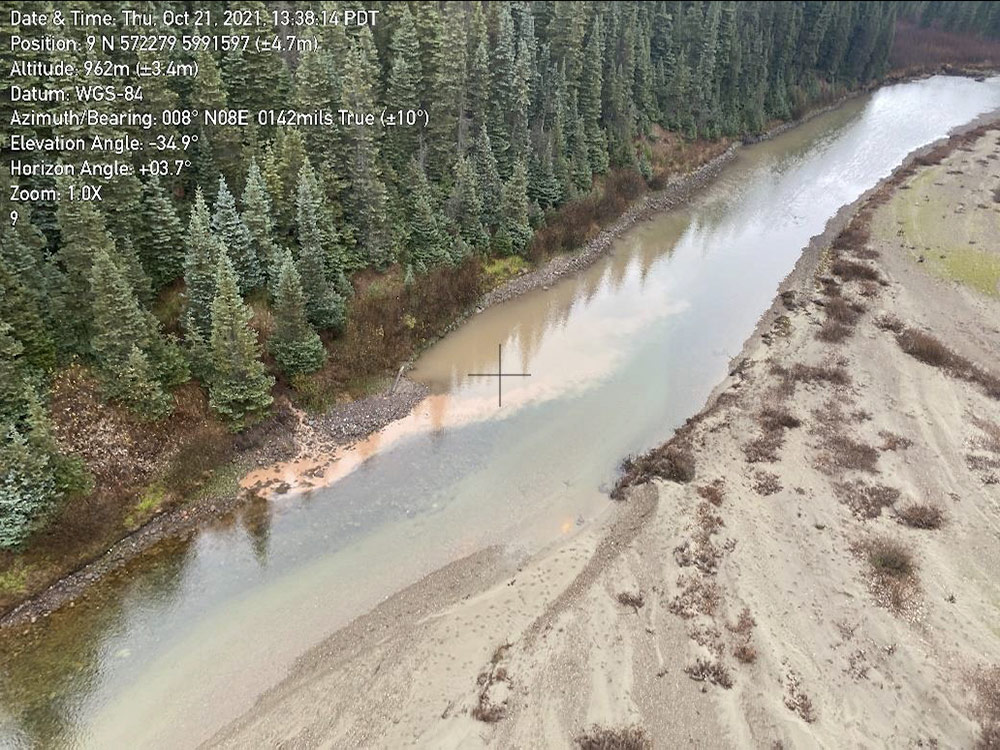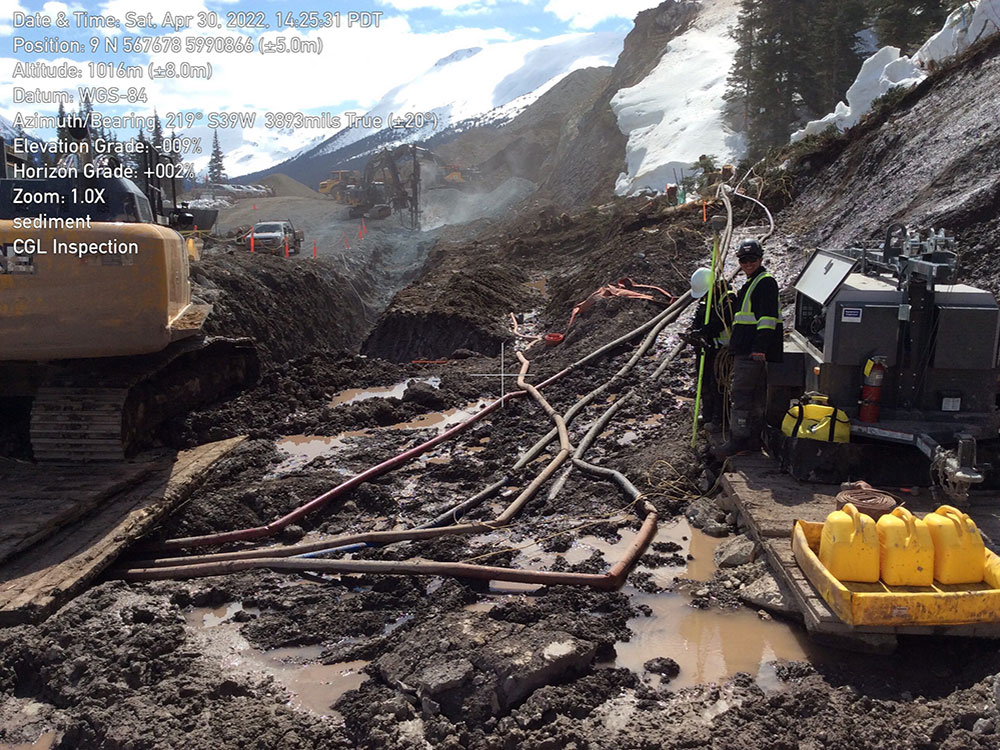The Office of the Wet’suwet’en is calling on the province to impose stricter penalties against Coastal GasLink after a recent inspection revealed continuing damage to watersheds in the western portion of the nation’s traditional territory.
Mike Ridsdale, environmental assessment co-ordinator with the Office of the Wet’suwet’en, said he visited a section of the pipeline route that’s currently under construction on April 30 with an investigator from B.C.’s Environmental Assessment Office and observed “many violations,” including erosion, sedimentation and several hydrocarbon spills. The Office of the Wet’suwet’en is a non-profit organization representing the nation’s traditional governance system.
He added that snowmelt and spring runoff are exacerbating the issues and impacting the Clore River, a tributary of the Skeena and one of three rivers flagged by the Wet’suwet’en as ecologically sensitive during the pipeline’s environmental approval process.
“The thing to remember here is that the Wet’suwet’en Hereditary Chiefs said that this was not a good project, and they said no to the project,” Ridsdale said. “What we’re seeing now is exactly what we were expecting.”
The province approved the project despite those concerns but has recently issued two fines against the company for violating its environmental certificate.
Ridsdale’s observations mesh with several inspection reports issued over the past year and a half by B.C.’s Environmental Assessment Office. They identified erosion and sediment control issues at numerous locations along the 670-kilometre project corridor, including in Wet’suwet’en territory, which encompasses almost a quarter of the pipeline route.
As a result, the province issued two fines to the company in recent months totalling almost $250,000. In an email, the company said it is working to address the problems along the route, which travels through complex terrain with shifting weather conditions.
“Coastal GasLink recognizes the concerns with respect to erosion and sediment control, and along with our prime contractors we are taking immediate action to implement changes that will improve EAO reports of non-compliance,” a company spokesperson said in the email to The Tyee.
“Erosion and sediment control is dynamic and changes constantly. We adapt along the way and are constantly evaluating places along the project that require attention and are working to ensure that erosion and sediment control is managed appropriately.”
The issues were first identified in October 2020, when Coastal GasLink was ordered to fix the problems and hire an independent auditor to observe compliance of construction activities. But the issues persisted, and the EAO recommended its first administrative penalty last fall.
In October, one year after they were first identified, EAO compliance and enforcement officers again reported that issues with erosion and sediment control continued and ordered the company to implement measures to control sedimentation into watersheds at multiple locations along the pipeline route.
In February, the EAO announced it would impose a $72,500 fine for the violations identified in spring 2021. It followed that announcement last month with news it would apply a second administrative penalty, this time for $170,100, for the infractions identified in October.
In an email to The Tyee following the announcement of the initial fine in February, Coastal GasLink said its issues had been resolved. Days later, the EAO posted new documents showing more erosion and sediment control issues had been identified, this time at the western end of the pipeline route near Kitimat.
A spokesperson with the province’s Environment Ministry could not provide a timeframe for when the EAO would release an inspection report based on the recent visit to Wet’suwet’en territory.
They confirmed that EAO compliance and enforcement officers had conducted inspections of the Coastal GasLink pipeline between April 25 and May 6 and that “Indigenous representatives accompanied officers on two of the inspection days.”
“The inspection records pertaining to those inspections are currently being drafted and will be publicly posted when they are finalized,” it said.
Ridsdale said that when he visited the pipeline route on April 30, there was still roughly a metre of snow in some areas, making it difficult to assess how sediment-laden runoff had affected wetlands. He said he and the EAO inspector travelled almost to Icy Pass, a remote high-alpine area at the western edge of Wet’suwet’en territory about 70 kilometres from the pipeline’s terminus in Kitimat.
The issues were observed near the Clore River, he said, a major tributary of the Copper River, which flows into the Skeena near Terrace, B.C. The Clore lies on the boundary of the coastal region, Ridsdale said, and as a result gets significant snowfall in winter.
“That was my issue, is that if they are doing sedimentation, we can’t see what the effects are on the wetlands themselves, because they’re under two to three feet of snow yet,” he said, adding the full impacts won’t be known until June.

What he did observe was soil and snow scraped from the surface of the pipeline’s right-of-way left in piles on a downslope where it would melt and flow directly into tributaries of the Clore River.
“As it warms up, that snow becomes sedimentation, which will flow downhill into the watershed,” he said.
He added that following the inspection, he learned via the BC Oil and Gas Commission that a slide had occurred in the area prior to his visit, but that on-site workers hadn’t informed him. “Some of the snow was melting and caused that soil pile to slide downhill,” he said.
In addition, Ridsdale said he and the EAO compliance and enforcement officer identified several fuel spills, which they reported to Coastal GasLink’s environmental monitor at the site. He said it concerns him that many others are not being reported.
“For us just to go once every couple of months… and do an inspection and find three or four spills, that’s pretty lax,” he said.
The BC Oil and Gas Commission confirmed in an email to The Tyee that it was aware of several hydrocarbon spills in the area, some of them from malfunctioning equipment, including 20 litres of hydraulic oil and 25 litres of diesel, gasoline and grease. It added that crews had cleaned up the spills and that sensitive environments had not been affected.
It also said Coastal GasLink is meeting its obligations to First Nations under B.C.’s Spill Reporting Regulation.
“The Commission provides notice to Indigenous Nations whenever a reportable incident occurs, and we also understand Coastal GasLink has provided information directly to Indigenous representatives,” it said.
But what defines a “reportable incident” doesn’t always include data important to the Wet’suwet’en, Ridsdale said, with some incidents falling beneath the threshold for reporting.
In a 25-page report produced by the Office of the Wet’suwet’en following the inspection, Ridsdale expressed frustration that the company doesn’t share more data with the nation, giving its natural resources department limited ability to assess impacts.
“As you may have noticed, the biggest concern is that there is no data being supplied to an outside entity, especially Wet’suwet’en people whose territory is being damaged and destroyed,” the report said. “The Wet’suwet’en have lived within our House territories for generations, and this is our legacy. The ability of a company to disregard a Nation’s protection directives, and do harm to their House is irresponsible, and damaging at many levels.”
It added that the Office of the Wet’suwet’en believes the project is out of compliance and should be subject to stricter penalties by the province.
“They have ignored BC EAO warnings for compliance on several issues,” it said. “CGL actions have demonstrated that the lack of repercussions for non-compliance is not altering their behaviour. Stronger non-compliance measures are needed to send a message that this is not acceptable practices.”
In an emailed response to The Tyee’s questions, Coastal GasLink said it has consulted with both Wet’suwet’en hereditary leadership and band councils since the start of the project “to listen and understand and to seek meaningful ways to address interests and concerns.”
It added that consultation with Indigenous groups, including the Office of the Wet’suwet’en, led to it receiving an environmental assessment certificate in 2014.
“Coastal GasLink has continued to engage through the Office of the Wet’suwet’en in an effort to understand issues and concerns related to the Project and identify mitigations to address those concerns, including with respect to environmental concerns,” it said, adding that it has had “more than 700 interactions” with the Office of the Wet’suwet’en in the past three years and that offers to meet with hereditary leadership did not receive a response.
“We remain committed to engaging with the Office of the Wet’suwet’en on interests and concerns related to the Project and continue to share information frequently to ensure they are aware of activities occurring in the Yintah,” it said.
Ridsdale said that while Coastal GasLink provides construction updates and other notices, they have not supplied data requested by the Office of the Wet’suwet’en or met with House groups whose territories are affected.
Although First Nations band councils along the pipeline route have signed agreements with Coastal GasLink, Wet’suwet’en traditional leadership has voiced opposition to pipelines through the nation’s territory for over a decade.
In the province’s 2014 environmental assessment report approving the project, the EAO noted Wet’suwet’en opposition.
“The [Office of the Wet’suwet’en] submits in its final documents provided to EAO that, in accordance with Wet’suwet’en law, EAO must recommend against approval of the proposed Project as it stands,” the document said. “The OW state that major components of proposed Projects within the mid-Morice watershed are in deep conflict with core Wet’suwet’en laws and values. EAO acknowledges that the OW recommends against approval of the proposed Project.”
Specifically, the Office of the Wet’suwet’en flagged concerns over river crossings for the Gosnell, Morice and Clore rivers, it said, with the latter being home to bull trout and an “isolated” species of rainbow trout, both of which are of particular concern to the nation.
“No additional mitigation was identified or required for these species or for other Clore River populations, beyond mitigations proposed for fish species generally,” the report said, adding that “there is no change in route being planned in order to avoid this area.”
The Clore is a culturally important environmental feature to the Laksamishu Clan, Ridsdale’s report noted, with “functioning cultural heritage, traditional use and knowledge that continues into the present.” It also hosts important wildlife and wildlife habitat, fish populations and fish habitat.
It shares a watershed with the Morice River, known to the Wet’suwet’en as Wedzin Kwa, which has been the focus of recent anti-pipeline actions on the nation’s territory. Concerns over environmental impacts from the project and infringement on Indigenous rights have led to dozens of arrests on Wet’suwet’en territory in recent years.
Last September, pipeline opponents, including Wet’suwet’en members, evicted Coastal GasLink workers from the area and blocked access to a worksite where the company plans to drill under Wedzin Kwa. In November, RCMP arrested 30 people at two locations in the area, including the drill site.
In February, Coastal GasLink reported that about 20 people had violently attacked the worksite, scaring away employees and causing millions of dollars in damage to equipment. RCMP have made no arrests in association with the incident and say the investigation is continuing.
In late April, the company said that cleanup at the site continues and that preparation for microtunnelling under Wedzin Kwa is underway. ![]()
Read more: Indigenous, Energy, Environment
















Tyee Commenting Guidelines
Comments that violate guidelines risk being deleted, and violations may result in a temporary or permanent user ban. Maintain the spirit of good conversation to stay in the discussion.
*Please note The Tyee is not a forum for spreading misinformation about COVID-19, denying its existence or minimizing its risk to public health.
Do:
Do not: